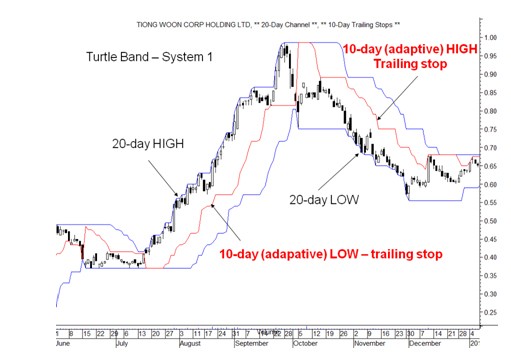Turtle Trading
Post on: 27 Июль, 2015 No Comment

motivated by e-mail from Mario R.
Okay, here’s the story (according to a PDF file that Mario sent me).
Note. The very best explanation I’ve found is here .
- Once upon a time there was this famous commodities speculator, Richard Dennis .
Dubbed the Prince of the Pit, he made $200M in ten years.
He funded each student with funds, from $500K to $2M, starting in Feb, 1984. They were called his turtles.
>Don’t tell me. You’re going to explain this Turtle Trading System, right?
Yes, if I can.
Though it’s meant to be applied to commodities trading, in things like coffee, cocoa, eurodollars, gold, silver, oil etc.. we’ll just talk about plain vanilla stocks.
>If Dennis made so much money, why didn’t he keep the system a secret?
Apparently, one (or more?) of his students is selling the system . making money without the consent of the originators of the system.
SO. another student has published a description of the original Turtle System .
>So what is this system?
Uh, yes, it goes like this:
- Each day we calculate TR. the T rue R ange. (See ATR )
That’s the maximum value of:
- (today’s High) — (today’s Low)
- | (today’s High) — (yesterday’s Close) |
- | (today’s Low) — (yesterday’s Close) |
We use the following prescription, calling the result N.
(If it were an ordinary, garden variety moving average rather than an exponential moving average, it might also be called Average True Range.)

Note that we need 20 days worth of data in order to begin our calculations.
>Huh? 19/20 and 1/20? Isn’t that the 19-day EMA?
Yes, but I’m just regurgitating the explanation given in the PDF file. so don’t worry about it.
>Why an exponential average. and why some True Range thing?
The True Range is a measure of the daily volatility, the price swings over a 24 hour period, the degree of violent behaviour — and we want some moving average smooothing, hence EMA so.
>Okay! Please continue.
Okay, armed with the value of N. we calculate a Dollar Volatility like so:
- Suppose that a 1 point change in the asset generates a change of $D in the contract. (D is Dollars per Point.)
- Dollar Volatility = N D
>Huh? Dollars per Point?
Yeah, that confused me, too.
In the Turtle System, practised by Richard Dennis (and his students), they were trading in futures.
For example, one futures contract for heating oil represents 42,000 gallons. (That’s 1000 barrels.)
Then, for heating oil, a $1 change in the price of heating oil would change the price of the contract by $D = $42,000.
Okay, now suppose you have $1M to invest. How much should you invest in the asset with a given Dollar Volatility.
>I give up.
That was a rhetorical question.
The Turtle answer is 1% of your equity per unit of Dollar Volatility .
That is, you build your position in the asset in Units.
Each unit is 1% of your equity for each unit of Dollar Volatility .
In other words, each Unit is:
Unit = (1% of Portfolio Equity) / (Dollar Volatility)














